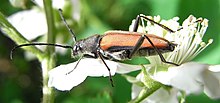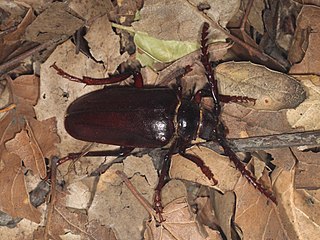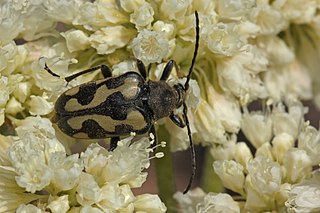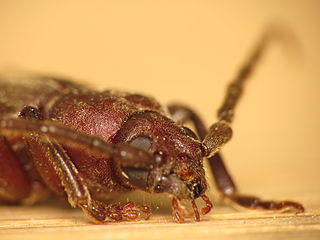| Anastrangalia | |
|---|---|
 | |
| Anastrangalia dubia | |
| Scientific classification | |
| Kingdom: | Animalia |
| Phylum: | Arthropoda |
| Class: | Insecta |
| Order: | Coleoptera |
| Family: | Cerambycidae |
| Subfamily: | Lepturinae |
| Tribe: | Lepturini |
| Genus: | Anastrangalia |
Anastrangalia is a genus of beetle in the family Cerambycidae, containing the following species: [1]

Beetles are a group of insects that form the order Coleoptera, in the superorder Endopterygota. Their front pair of wings are hardened into wing-cases, elytra, distinguishing them from most other insects. The Coleoptera, with about 400,000 species, is the largest of all orders, constituting almost 40% of described insects and 25% of all known animal life-forms; new species are discovered frequently. The largest of all families, the Curculionidae (weevils) with some 80,000 member species, belongs to this order. Found in almost every habitat except the sea and the polar regions, they interact with their ecosystems in several ways: beetles often feed on plants and fungi, break down animal and plant debris, and eat other invertebrates. Some species are serious agricultural pests, such as the Colorado potato beetle, while others such as Coccinellidae eat aphids, scale insects, thrips, and other plant-sucking insects that damage crops.

The longhorn beetles are a cosmopolitan family of beetles, typically characterized by extremely long antennae, which are often as long as or longer than the beetle's body. In various members of the family, however, the antennae are quite short and such species can be difficult to distinguish from related beetle families such as the Chrysomelidae. The family is large, with over 26,000 species described, slightly more than half from the Eastern Hemisphere. Several are serious pests. The larvae, called roundheaded borers, bore into wood, where they can cause extensive damage to either living trees or untreated lumber. A number of species mimic ants, bees, and wasps, though a majority of species are cryptically colored. The rare titan beetle from northeastern South America is often considered the largest insect, with a maximum known body length of just over 16.7 cm (6.6 in). The scientific name of this beetle family goes back to a figure from Greek mythology: after an argument with nymphs, the shepherd Cerambus was transformed into a large beetle with horns.
- Anastrangalia dissimilis (Casey, 1891)
- Anastrangalia dubia (Scopoli, 1763)
- Anastrangalia haldemani (Casey, 1891)
- Anastrangalia kasaharai (Makihara, 2002)
- Anastrangalia laetifica (LeConte, 1859)
- Anastrangalia montana (Mulsant & Rey, 1863)
- Anastrangalia renardi (Gebler, 1848)
- Anastrangalia reyi (Heyden, 1889)
- Anastrangalia rubriola (Bates, 1878)
- Anastrangalia sanguinea (LeConte, 1859)
- Anastrangalia sanguinolenta (Linnaeus, 1761)
- Anastrangalia scotodes (Bates, 1873)
Anastrangalia dissimilis is a species of beetle from Cerambycidae family.

Anastrangalia dubia is a species of beetle from Cerambycidae family.
Anastrangalia haldemani is a species of beetle from Cerambycidae family, that could be found in Canada, United States, and Mexico.










